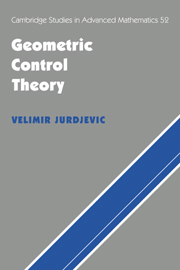Book contents
- Frontmatter
- Contents
- Introduction
- Acknowledgments
- Part one Reachable sets and controllability
- Part two Optimal control theory
- 7 Linear systems with quadratic costs
- 8 The Riccati equation and quadratic systems
- 9 Singular linear quadratic problems
- 10 Time-optimal problems and Fuller's phenomenon
- 11 The maximum principle
- 12 Optimal problems on Lie groups
- 13 Symmetry, integrability, and the Hamilton-Jacobi theory
- 14 Integrable Hamiltonian systems on Lie groups: the elastic problem, its non-Euclidean analogues, and the rolling-sphere problem
- References
- Index
14 - Integrable Hamiltonian systems on Lie groups: the elastic problem, its non-Euclidean analogues, and the rolling-sphere problem
Published online by Cambridge University Press: 07 October 2009
- Frontmatter
- Contents
- Introduction
- Acknowledgments
- Part one Reachable sets and controllability
- Part two Optimal control theory
- 7 Linear systems with quadratic costs
- 8 The Riccati equation and quadratic systems
- 9 Singular linear quadratic problems
- 10 Time-optimal problems and Fuller's phenomenon
- 11 The maximum principle
- 12 Optimal problems on Lie groups
- 13 Symmetry, integrability, and the Hamilton-Jacobi theory
- 14 Integrable Hamiltonian systems on Lie groups: the elastic problem, its non-Euclidean analogues, and the rolling-sphere problem
- References
- Index
Summary
Having incorporated into optimal control theory the contributions made by the calculus of variations, mechanics, and geometry, we can begin to appreciate the exciting and challenging possibilities that this enriched subject offers back to geometry and applied mathematics. We have seen that the most remarkable equations of classic applied mathematics appear as only natural steps in the context of geometric control theory. In this chapter we shall again turn to the classic past to find inspiration for the future. We shall reconsider Kirchhoff's elastic problem in the Euclidean space E3 and his famous observation of 1859 that the elastic problem is “like” the heavy-top problem, known since then as the mechanical or kinetic analogue of the elastic problem.
Brilliant, but baffling, Kirchhoff's observation has had lasting influence on subsequent generations of mathematicians interested in the elastic problem who have sought to understand its solution through the analogy with the heavy-top problem. That view of the elastic problem partly explains why it has always been in the shadow of the heavy-top problem and is also partly responsible for its relative obscurity outside of the literature on elasticity.
Our treatment of variational problems on Lie groups in Chapters 12 and 13 shows clear connections between these two problems and provides natural interpretations for the famous observation of Kirchhoff: The heavy-top problem is “like” the elastic problem, and the analogy with the elastic problem illuminates its solutions, rather than the other way around as previously understood.
- Type
- Chapter
- Information
- Geometric Control Theory , pp. 444 - 482Publisher: Cambridge University PressPrint publication year: 1996

